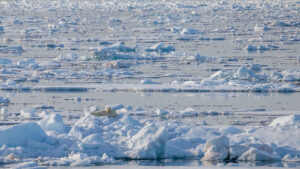Physical Address
23,24,25 & 26, 2nd Floor, Software Technology Park India, Opp: Garware Stadium,MIDC, Chikalthana, Aurangabad, Maharashtra – 431001 India
Physical Address
23,24,25 & 26, 2nd Floor, Software Technology Park India, Opp: Garware Stadium,MIDC, Chikalthana, Aurangabad, Maharashtra – 431001 India

In an alarming revelation, scientists have found that the Arctic Ocean is undergoing rapid acidification with rates three to four times higher than in other oceans. This is happening because of the climate change-driven sea ice melt, the scientists have concluded. The study, published in Science, is the first analysis of Arctic acidification that includes data from more than two decades, covering the period from 1994 to 2020.
The team of researchers from the Polar and Marine Research Institute at Jimei University, China, and the School of Marine Science and Policy at the University of Delaware in the US found that due to climate change-induced sea ice retreat, a larger area of seawater that was initially covered by ice has been exposed to the atmosphere. This is promoting faster uptake of atmospheric CO2, thus leading to drastic ocean acidification. The acidification, in turn, is threatening the survival of plants, shellfish, coral reefs and other marine life and biological processes in the oceans of the planet.
Scientists involved in the study have expressed fears that by 2050, Arctic sea ice will no longer survive during the increasingly warmer summer seasons. This will result in the ocean turning more acidic since there will be no ice cover for protection.
ScienceDaily quoted Wei-Jun Cai, co-author of the study and the University of Delaware, Marine Chemistry Expert as saying, “If all of the multiple-year ice is replaced by first-year ice, then there will be lower alkalinity and lower buffer capacity and acidification continues,” he said. “By 2050, we think all of the ice will be gone in the summer. Some papers predict that will happen by 2030. And if we follow the current trend for 20 more years, the summer acidification will be really, really strong.”
The ScienceDaily report further quoted Cai saying that ‘more research is required to further refine the above mechanism and better predict future changes, but the data so far show again the far-reaching ripple effects of climate change.’
The scientists involved in the study also expressed shock at the fast rate of acidification of the Arctic Ocean. They further showed concerns about the cost involved in terms of biological systems in the region.
The Guardian quoted Wei-Jun Cai, as saying, “In other ocean systems, acidification is being driven by an increase in atmospheric carbon dioxide, which is increasing at a rate of around 2ppm [parts per million] per year. We were shocked to see acidification is happening three to four times faster (in case of the Arctic Ocean). The ice melt dilutes or lowers the alkalinity of the seawater. This dilutes the buffering capacity of the water, and its ability to resist acidification. In lower latitudes, you have coral reefs and if you add carbon dioxide to the water, the carbon saturation rate will increase and the coral won’t grow. We are far from knowing what the cost is for biological systems. We don’t know what organisms could be affected. This is something the biological community needs to look into.”
How sea-ice melt is contributing to faster acidification in the Arctic
According to scientists, the sea ice melt is contributing to rapid acidification in three main ways. They are:
First, the ‘earlier unexposed’ and ‘now exposed’ water under the sea ice had a deficit of carbon dioxide. It can now take up carbon dioxide easily as it is now exposed to the carbon dioxide in the atmosphere.
Second, the carbon dioxide taken from the atmosphere is concentrated at the surface as the seawater mixed with meltwater is light preventing it from easily mixing into deeper waters.
And third, the seawater is failing to neutralize the carbon dioxide into bicarbonate which is resulting in a rapid decrease in the ocean pH or an increase in ocean acidification. This is happening because the meltwater is diluting the carbonate ion concentration in the seawater.
The rapid retreat of Arctic sea ice
In the past, the Arctic sea ice was not undergoing rapid melt during the summer seasons but was concentrated in shallow marginal regions. From the 1980s, the situation started to change and in the last 15 years or so, the melt has accelerated involving regions deeper into the north. Earlier, a separate study found that the Arctic has warmed at about four times the global average rate over the past 43 years. The researchers had said that faster warming is a feedback process driven by melting sea ice, which is also driving faster acidification.

Ocean Acidification
According to scientific data, oceans together are absorbing around 30% of human carbon emissions. This is helping us to fight climate change by reducing atmospheric carbon dioxide excess but this is also taking a toll on the oceans decreasing the pH and making them more acidic. Scientists have warned that ocean acidification is one of the nine planetary boundaries if transgressed might put the entire human civilization under threat. The World Meteorological Organization (WMO) report released in May 2022 found that four key climate change indicators were at all-time highs and one of them is ocean acidification.
A study has found that ocean acidification is already putting stress on coral reefs around the Indian Ocean and Asia. The primary solution to ocean acidification is reducing carbon emissions, scientists have concluded. Some researchers are trying to find out other solutions like depositing alkaline rock minerals into oceans.
Comments are closed.
[…] ඉංග්රීසි බසින් පළවූ මෙහි මුල් ලිපිය මෙතනින් […]